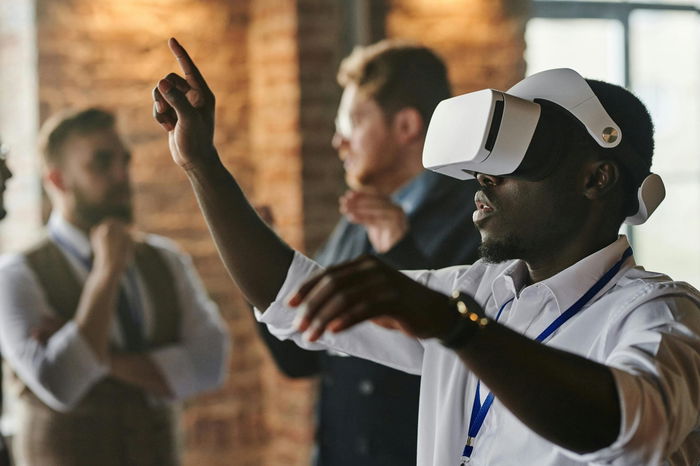It’s not a question of if extended reality (XR) becomes mainstream; it’s a question of when. With that “when” swiftly approaching, Jobs for the Future (JFF) is invested in ensuring everyone has access to, helps create, and benefits from XR technology. As part of this mission, we hosted three hackathon-style “Innovation Challenges” in Denver, Dallas, and Washington, DC, with the support of Meta.
These Challenges were rooted in the goal of expanding access to the XR conversation by focusing on creating solutions for small businesses. In the Denver Challenge, participants were asked to design solutions for the Denver International Airport, given the number of small business vendors that work at and with the airport. In the DC Challenge, participants were asked to design solutions for small businesses in the restaurant industry.
To dig deeper into their experiences with the Challenge and why expanding access to XR matters, we interviewed two Innovation Challenge competitors, Nosa Iyare and Joseph Cathey. They shared their thoughts on how small businesses can build and benefit from XR technology that centers their needs.

Nosa Iyare, founder, Overwrite, Inc., Tourist AR
I’m an immigrant; I moved here to the United States in 2017, and as with most immigrants, navigating the airport was one of my first challenges. So when I was presented this opportunity to hack away on possible solutions, that was the first thing my mind went to: How do we help immigrants like myself trying to integrate into society using XR technology?
Tourist AR is pretty much an augmented reality app to help first-time visitors to an airport to be able to navigate the airport better. If you visit an airport, there are all these signs in different languages. You might not understand English, if you’re from a foreign country. The airport can be very intimidating, particularly for immigrants who are not used to such big airports, or complicated systems of checking your bags, getting your bag, or going through immigration.
My solution was an application that you can use on your phone and it can help you see the airport better. As you’re viewing the airport it shows you signs and translates them to different languages in real time. It can help you with routing, and give you real-time updates on your situation when you have to go through immigration and things like that. So, an augmented reality app to help immigrants better navigate their first three hours in a new country.
I think there is huge [importance of designing for small businesses], being a small entrepreneur myself. Because small business owners are left out.
They tend to only get access to simple technology, like payments, and small businesses only tend to get on board years and years and years after the technology has been democratized. They’re not really involved in the building process for the most part, and that’s why it’s important that this technology is made available to small businesses— not just as users, but also as part of the design process to building process to make sure that they can contribute.
Technology is just a tool to be used to solve problems and if the people facing those problems are given the opportunity to participate in the design of those solutions, then I think it would just be better for everyone.
If you don’t include small business in the conversation, there’ll be a lot of time wasted. I know that for sure.
That’s really important as well because small business owners think differently than a lot of large corporations and technology companies. So something that might be very rudimentary to a large corporation might be significantly important to a small business. Sometimes that gets lost in translation between those two axes.

Joseph Cathey, founder, Capitol Interactive
For the DC innovation challenge, we created a solution called the District Pass, which is a sort of hybrid of TikTok and Pokémon Go. We wanted to create a tool for small businesses to help them get discovered by local and visiting customers and then offer those customers an incentive for return visits.
Unlike a lot of existing vertical video platforms, which are flooded with lots of information to sift through, we wanted to create a more curated hyperlocal feed specifically for featuring local businesses and artists. In doing so, we wanted to make it easier for people to both discover those places, and then to integrate a gamified AR mapping element to really encourage them to get out there and check them out.
So the way in which the gamified AR maps part of the application works is we have a map that shows users all of the local businesses nearby. When the users go and visit one of these locations, they’re able to play an augmented reality game there at that location, and in doing so, they earn points that rank them on a local leaderboard and allow them to spend those points on rewards from local partners. This could be a restaurant or brewery that offers a free or discounted appetizer or drink, an art gallery that offers free stickers of some of their most popular prints, or a museum or venue that offers exclusive discounts on merch.
To really make an impact with the application, we’ve been working with local partners in DC to figure out the best way to get this in the hands of as many businesses as possible, and to make sure that the tools we’re offering work and make sense for them. I think the number one thing for us [when connecting with small businesses] is just making sure they have an understanding of what the technology is and how it benefits them.
If I say to a business owner, “Hey, I can show 3D models of your menu,” that doesn’t mean anything to them. But if I hand them an iPad and say “Check this out,” and then all of a sudden they see their signature sandwich on a table in front of them—that means something to them, right?
And what’s great about that is this technology is more accessible and in reach than ever before. I think there’s a lot of outreach that has to be done to help them start to reap the benefits of that. You’re going to obviously have some business owners that are more tech-savvy than others. And maybe they’re not ready for augmented reality or content. But they’ve certainly already been creating vertical videos for Instagram reels, for TikTok, for Facebook for all the other social channels.
They can repurpose that content into the video discovery feed, and then if they start seeing results, we can say, “Hey, here’s a low-cost way for you to add content and augmented reality content to your profile on this application.”
Maybe they’re not ready to jump in all the way. But if you meet them where they’re at and say, “Hey, look, this is low effort on your part,” then I think you can help to get them to a place where it’s really going to be impactful.
Ultimately, everybody just wants to see results. And I think offering a graduated on-ramp for them is a great way to do that.
Interviews have been edited and condensed for clarity and conducted by Taelyr Roberts, senior manager at Jobs for the Future (JFF).





